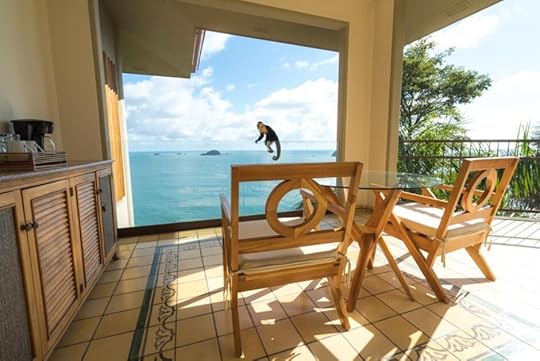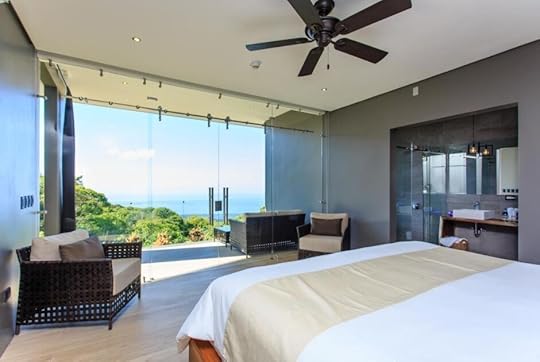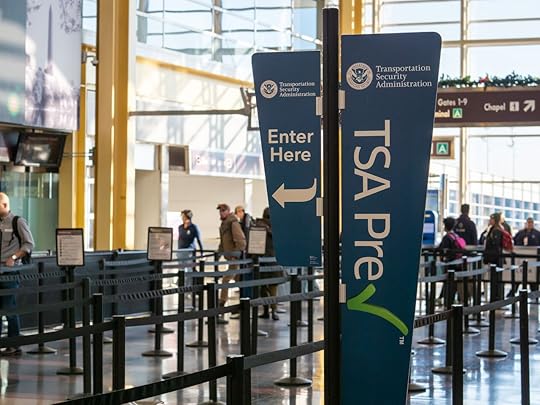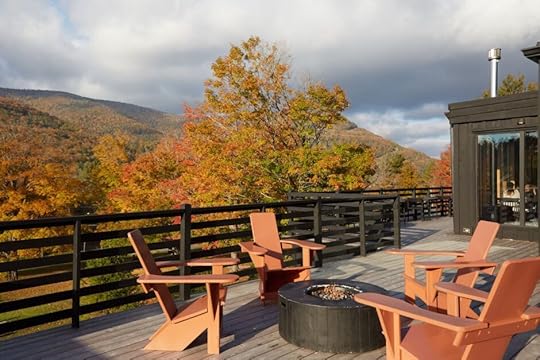Matador Network's Blog, page 579
October 5, 2021
Watch what happens when a wind storm throws dozens of tents into the sky

It’s safe to say that most people wouldn’t expect to see a group of tents flying through the sky on their camping trip. But that’s exactly what’s depicted in a TikTok as a large campsite’s worth of tents are thrown into the air due to what appears to be a wind storm.
@yaseigenshiroDear the fxxking wind😤Off there goes my tent #campingideas #campingtrip #campingtent #campfire #tornado #tornado2021 #rvlifestyle #vanlifetravel
You can see many different color tents in the air flying around like a kite in the wind. Most campers are either standing in awe or filming (and, presumably, wondering if they’re ever going to get their tent back).
The video inspired a number of jokes in the comment section. User wildmanmike commented, “Tent company having a blowout sale,” while user littlebowcreep commented, “There’s so many of them it almost feels in*tent*ional.” User jonnywaldes chimed in with “That storm is category tent.”
Others were confused why proper measures weren’t put in place so the tents didn’t fly away in the first place. User jstclmesir commented, “I count 44 people who were today years old when they learned about the importance of staking your tent.”
If you’re planning your next camping trip in a windy locale and don’t want your tent to end up in the sky, follow the basic instructions on how to pitch the perfect tent, and then take note of these wind-friendly tips from Camping Valley:
Choose your location wiselyErect the tent properlyUse extra pegs and guy ropes to anchor your tentRemove the sidewallsHandle repairs immediatelyPoint the tent towards the wind More like thisCampingThe best places to camp in all 50 states
More like thisCampingThe best places to camp in all 50 statesThe post Watch what happens when a wind storm throws dozens of tents into the sky appeared first on Matador Network.
How to play the ‘Squid Game’ dalgona candy challenge without leaving your house

The hit Netflix show Squid Game has turned a once relatively niche South Korean candy into a hot commodity. It’s all centered around dalgona, which is a honeycomb toffee with a name that’ll be familiar to anyone who took part in the (unrelated) dalgona coffee trend that boomed on TikTok last year.
Dalgona is sweet, but the concept behind how it’s used in Squid Game is not. Characters in the show must complete games that are popular among South Korean children. They win money if they’re successful, and they may be shot if not.
For the dalgona game, contestants have to carefully break the toffee candy around a preset shape without breaking the whole thing. The show depicts four shapes: circle, star, umbrella, and triangle (street vendors and candy purveyors, however, offer many more options). Fans of the show have taken to YouTube and TikTok to test their candy shaping skills — albeit without the threat of death or the thrill of prize money.
According to Reuters, An Yong-hui, who owns a candy shop in Seoul and provided the candy for Squid Game, hasn’t been able to keep up with all of the people rushing to buy dalgona. Sales went from less than 200 per day to more than 500 per day after the show premiered in mid September.
It’s been a boon for a candy that has fallen out of favor in recent years. Reuters reports that dalgona has long been hawked by sellers in front of schools, though popularity has slowed since the early 2000s. Squid Game was written to tug on the nostalgic childhood games and touchpoints people knew growing up, making dalgona ripe for a revival.
If you want to give the game a go and see if you would survive, your best bet is to make some of the candy for yourself. All you need to do is caramelize some sugar, add a touch of baking soda, stir, and then pour it onto a non-stick mat and flatten while it’s still warm. Then, grab your favorite cookie cutter (if you’re playing the game, just remember a circle would be easier than, say, a gingerbread man) and press it down. Wait for it to cool, then break along the perforated edges without breaking any of the shape from the cookie cutter.
Good luck!
The post How to play the ‘Squid Game’ dalgona candy challenge without leaving your house appeared first on Matador Network.
These Costa Rica hotels put you up close to amazing wildlife experiences

COSTA RICA boasts one of the highest densities of biodiversity of any country in the world and much of its wildlife can be enjoyed without having to leave the confines of your hotel resort. From sloths to sea turtles, as well as more birds than you can shake a pair of binoculars at, the success of Costa Rica’s animal species can partly be attributed to the country’s world-leading attitudes towards ecotourism, with many of its leading hotels positioning themselves on the cutting edge of wildlife conservation and reforestation projects. These Costa Rica hotels put sustainability first and offer the best and most unique opportunities to experience the country’s incredible wildlife.
We hope you love the spaces and stays we recommend! Just so you know, Matador may collect a small commission from the links on this page if you decide to book a stay. Listed prices are accurate as of the time of publication. See our full Advertiser Disclosure here.
Arenas del Mar Beachfront & Rainforest Resort — Puntarenas
Photo: Booking.com
In Manuel Antonio National Park, a jungle paradise on Costa Rica’s Pacific coast, lush vegetation rich in flora and fauna spills out onto some of the country’s most spectacular white-sand beaches. For the quintessential Manuel Antonio experience, stay at Arenas del Mar, the only rainforest resort in the area with premium beach access direct from your lodging.
Wake up to the sound of the waves lapping against the shore of your own beach or join the early birds on the 6:00 am birdwatching tour and listen as the dawn chorus brings the jungle to life while you explore Arenas del Mar’s eleven acres of secondary forest with one of their resident naturalist guides. Wildlife abounds at this luxury beach resort, so don’t be surprised to see sloths and any one of the four types of monkey swing by during breakfast and your evening beachside barbecue at the Playitas Restaurant on the resort’s private beach.
Price: From $294 per night
Laguna Lodge — Limon
Photo: Booking.com
The murky brown waterways of Tortuguero National Park are a haven for wildlife, and the Laguna Lodge places you right in the heart of this wetland wilderness. Accessible only by boat, this ecolodge rests on a spit of sand that separates the Caribbean Sea from one of the many canals and lagoons that make up the labyrinth that is Tortuguero. It’s one of the most beautiful — and private — of Costa Rica hotels. Take advantage of the full repertoire of activities that Laguna Lodge has on offer: expect to see caimans, crocs, sloths, howler monkeys, and even river dolphins on the boat tour or discover the park’s under your own steam on the guided kayak tour.
Tortuguero’s main draw, however, is the sea turtles. This tiny stretch of sand is one of the most important turtle nesting sites on the whole Caribbean coastline. Laguna Lodge runs night tours in its own backyard during nesting season (July to October) and hatching season (September to November). Visit in October and you might be privileged enough to experience both.
Price: From $116 per night
Nayara Gardens, Nayara Springs, and Nayara Tented Camps Resorts — La Fortuna
Photo: Booking.com
At the foot of Arenal, Costa Rica’s most famous volcano, lies a once-barren landscape that’s been laboriously restored into verdant rainforest by the efforts of the Nayara Resorts group. Their hotel complex consists of three separate collections in one location, but while the lodgings in the Nayara Springs (adults only) and Nayara Gardens are exquisite, Nayara’s jewel is its Tented Camp.
Here you can watch in awe as macaws and toucans flash overhead while you enjoy a floating breakfast from your own private infinity pool at one of Nayara’s safari-style luxury tents. Later, roam the rest of the Nayara complex on the lookout for more animals, especially from the forest’s hanging bridges where in-house expert naturalists are always on hand to name for you a particular bird or butterfly or point you in the direction of the nearest resident sloth.
Price: From $280 per night
Parador Resort and Spa — Punta Quepos
Photo: Booking.com
Parador Resort and Spa was one of the early standard-bearers for sustainable luxury in Costa Rica. Located at the edge of Manuel Antonio National Park, Parador is a veritable haven for tropical birds, monkeys, and especially sloths – the hotel’s extensive grounds are a popular release site for the Sloth Institute, a non-profit that works tirelessly to rehabilitate injured animals. For the best wildlife watching, join one of Parador’s knowledgeable on-site naturalists on a tour of the two-kilometer “monkey trail” that loops through the dense secondary forest preserved on the hotel grounds.
Here, sightings of the impudent white-faced capuchins are guaranteed – but you’ll most likely have already caught them sipping from one of the hotel’s three infinity pools. At the end of the day, savor the sunset over the Pacific from your suite terrace before heading down to the outstanding restaurant to sample chef Rodrigo Salazar’s world-class menu, served up using only the very best locally sourced foods.
Price: From $189
Chachagua Rainforest Hotel and Hot Springs — La Fortuna
Photo: Booking.com
Chachagua Rainforest Hotel and Hot Springs is folded into ninety-four acres of exquisite forest which serves as part of a biological corridor for some of the country’s most exciting animal and bird species, including the elusive puma. The resort offers a broad range of excursions in partnership with small, locally run tour operators as well as two excellent on-site tours on the wild grounds themselves.
The Night Hike Frog March brings you up close and personal with Costa Rica’s iconic red-eyed tree frog and other creatures of the night, while the day tour follows a meandering trail that will see you strafing waterfalls and fording bubbling brooks on the hunt for wildlife. At the end of the tour, children are handed the opportunity to plant their own tree on the hotel’s grounds: a neat metaphor for Chachagua’s commitment to preserving the rainforest for future generations.
Price: From $97 per night
Rancho Pacifico — Uvita
Photo: Booking.com
Rancho Pacifico is an award-winning blend of eco-tourism and luxury living perched in the foothills of Uvita’s coastal mountains and overlooking the famous Whale’s Tail beach on the Pacific Ocean. Regularly touted as one of Costa Rica’s most romantic retreats, this adults-only five-star resort is about more than just fine dining and spa treatments: it is also one of the best places in the country to spot humpback whales.
For the best chance of seeing them, visit during the peak months of September and October and join a whale-watching tour organized by the hotel. After a day on the water, retire to your luxury treehouse lodgings where the floor-to-ceiling windows bring the jungle into your room. Then take to your private decking for a soak-in hot tub, cocktail in hand, and keep your eyes fixed on the ocean horizon to catch another glimpse of those extraordinary mammals. 
Price: From $395 per night
More like thisParks + WildernessHow to experience the incredible biodiversity of Costa Rica’s Monteverde Cloud ForestThe post These Costa Rica hotels put you up close to amazing wildlife experiences appeared first on Matador Network.
These large, family-friendly Airbnbs in the Southwest make the perfect holiday getaway

A holiday getaway shouldn’t be stressful. You can rest easy knowing that at least finding the right place to stay won’t be booked by now. The Southwest is ideal because it ticks all the boxes — snow or desert, pool or sauna, hike or ski, it’s all doable here in the winter. Getaway this holiday season with these family holiday Airbnbs in the Southwest.
We hope you love the spaces and stays we recommend! Just so you know, Matador may collect a small commission from the links on this page if you decide to book a stay. Listed prices are accurate as of the time of publication. See our full Advertiser Disclosure here.
Luxury cabin in the pines near Flagstaff and Grand Canyon
Photo: Airbnb
Flagstaff, Arizona, is America’s most underrated small city. It’s surrounded by pine forests and mountains, nearby to skiing, snowshoeing, hiking, and the famed desert of the southwest. And it’s also a major hub for accessing the Grand Canyon. This luxury cabin outside of town puts you right next to all of the above. First, there’s a toasty hot tub in which to soak. It also comes with a game room and pool table, a kids’ playground outside, and ample space to cook, lounge, watch movies and sports, and commune with the people you only see once per year. It’s at once convenient and cozy, but never crowded.
Ten guests, four bedrooms
Price: $246 per night

Photo: Airbnb
Have a truly southwest holiday at Rancho San Marcos, just outside Sante Fe, New Mexico. This massive estate has room for the entire extended family and includes kivas, a hot tub, and Spanish architecture built around spacious courtyards. There’s a fireplace and pool table, and a large living room. Should the youngsters receive gifts that require a bit room to enjoy, they’ll have both indoor and outdoor options here. Santa Fe is known for its holiday spirit, and the smaller town of Madrid is just up the road as well for essentials.
Sixteen guests, six bedrooms
Price: $1,386 per night

Photo: Airbnb
It’s not every year that you get to swim on Christmas. Make this the year in this gorgeous estate in Tucson dubbed The Alisa. The property features expansive views of the surrounding desert hills from large windows in the living space. Hanging in the living room here is akin to lounging in a high-end resort, especially if you have a hot toddy or, dare we say, an egg nog to raise for a toast. The chef’s kitchen is stocked and ready for your holiday meals. Iconic, clean, and emblematic of its southwest location, you won’t find a better host location for a holiday family retreat. All this with the Catalina Foothills as your backdrop.
Eleven guests, four bedrooms
Price: $441 per night

Photo: Airbnb
Bring the family to Durango, Colorado, this holiday season and stay in style at this creekside retreat just outside town. Tucked between Durango and Bayfield, you’ll experience the beauty and serenity of the San Juan Mountains and enjoy warm cocktails on the deck to the sound of a flowing creek. You’ll be within an hour of the slopes at Purgatory, and 90 minutes to Wolf Creek Ski Area. Durango is also known for the Bar D Wranglers, a western cookout and show featuring live music and a chuckwagon dinner.
Ten guests, four bedrooms
Price: $541 per night

Photo: Airbnb
Southern Utah is among the most beautiful places in the world. You have the desert, the mountains, and the water within a day’s drive. Many of the most striking natural features — including Bryce Canyon National Park and Utah’s other national parks — are within reach as well. And the home itself is a stunner. High-ceilinged living spaces hosting massive bay windows, allowing you to look out into the snow-covered forest. The kitchen is top-notch and so are the sleeping spaces. Kids have plenty of space to be themselves, and adults can do so along with them or segregate themselves for a cocktail in an entirely separate area of the house. You won’t find a more luxurious estate within this price range, making this one a win-win for all involved.
Ten guests, four bedrooms
Price: From $228 per night

Photo: Airbnb
Unless you live in west Texas or southern New Mexico, Ruidoso might not be on your “epic mountain towns” radar. But, it should be. Ruidoso is everything a mountain town should be — think hearty dining, craft beer, shopping, and endless outdoors access — and this luxurious home gives you access to the best of it. There’s an outdoor hot tub where you can soak while soaking in the views of the pines. The home is fully equipped for family reunions, large buffet meals, and movie nights around the fire. No matter a person’s interest, there’s something for everyone here in southern New Mexico.
Nine guests, three bedrooms
Price: From $254 per night

Photo: Airbnb
Chill in the pool. Play ping pong or pool in the game room. Cook a holiday feast in the decked-out kitchen. It’s all doable in this Palm Springs mansion. And you have the benefit of warmer weather and nearby trails. You can even work on your putting game on the private green. With all the amenities you’d expect at a Palm Springs resort, you at least won’t need to worry about the accommodations aspect of a massive family trip. 
Eight guests, four bedrooms
Price: $684 per night
The post These large, family-friendly Airbnbs in the Southwest make the perfect holiday getaway appeared first on Matador Network.
These Puerto Rican neighborhoods turned street art galleries are made for Instagram

It’s nearly impossible to find parking in Yauco, Puerto Rico. The steep, narrow roads are packed with cars on either side. Occasionally, you’ll pass a rogue chair serving as a placeholder for a resident’s vehicle. There’s a steady hum of tourist footsteps all heading towards one place — Yaucromatic.
Just a few years ago this neighborhood wasn’t on any visitor’s map. Today, it’s a sought-after location for Instagrammers and a background for music videos and commercials. It has become one of the most popular attractions on the island, giving visitors a reason to venture beyond San Juan and driving economic growth to a previously neglected area.
Yaucromatic is a street art gallery displaying macro murals on privately owned houses. In contrast to regular murals, which typically take up a single wall, macro murals cover several buildings to form one cohesive image. They are a testament to the power of paint to transform and rejuvenate property, as well as the morale of those around it. What started as 16 murals before Hurricane Maria (fall 2017) has grown to 62 murals in the years that followed. Guests can self-navigate the street art using an interactive map online.

Photo: Pintalto/Facebook
Yaucromatic is not the first macro mural neighborhood on the island, however, or even the biggest. It’s part of a broader vision brought to life by Samuel González, founder of Pintalto, Inc. In coordination with local groups like Arte Para Unir (Art to Unite) and municipal governments, Pintalto has now completed macro mural projects in five Puerto Rican towns: Manatí, Yauco, Aguadilla, Las Piedras and Rio Grande. The project in Aguadilla is the largest.
González is an architect by trade but dreamer in practice. He grew up in Manatí and was inspired by public art in countries like Mexico and Brazil. Wanting to contribute something meaningful to his hometown, he imagined what it would be like to take neighborhoods considered “dangerous” or “run-down” and make them a canvas for larger-than-life pieces representative of the local culture.

Photo: Author
“I was surprised when I pitched the idea to residents and they actually liked it. I thought it was a little out there and that I’d get some resistance, but we got a majority of the community on board. From there, the next step was finding funding,” González recalls.
A local credit union lent the funds for paint. The municipality helped clear out trash and prepare the area. Volunteer groups started pouring in, every weekend without fail, from schools or churches. The project has since become a major draw for street artists but at its core, it was art by and for the people.
The colorful walls that distinguish the initiative from any other street art pieces on the island can be attributed to the first and only mural in the Manatí project painted by González’s friend, Nathaneal Oyoala. Oyoala created an image of a cancer patient holding a cricket from which “colors of hope” were emanating. Today, those colors — a mosaic of vibrant hues of yellow, blue, pink, orange, green and purple — blanket neighborhoods throughout the island.

Photo: Pintalto/Facebook
Oyoala’s mural is an optical illusion that when seen at the right angle looks as if the neighborhood is on the same plane as the image beneath it. It is symbolic of Pintalto’s mission to change your perspective of forgotten places.
Yauco’s first set of murals were completed in record time — just three weeks. Residents picked up paint brushes and contributed their time and manpower to the cause. González notes, “The success of Yaucromatic was immediate. From opening day, there were crowds of people walking up and down the neighborhood. Within three months of opening, well-known reggaeton artist Ozuna filmed a video there, reaching a new generation and urban audience outside of Puerto Rico.”
“The case of Yauco was a special one that I don’t think will repeat itself,” González says. “It was a case where all the planets aligned for the project to take off. Even though I would have liked for it to be Manatí, Yauco paved the way for subsequent projects. The level of international attention, popularity and interest it has received cannot be replicated.”

Photo: Pintalto/Facebook
The effect of the street art on the town itself should not be minimized, either. In the wake of Yaucromatic, the neighbors became re-engaged and formed an association now tasked with keeping the area clean, retouching themurals, and managing street vendors. Residents proudly showcase their homes, sitting outside for hours to greet and welcome those interested in learning more. Touring the neighborhood is free, as it’s meant to be art accessible to all instead of hidden behind the walls of a museum. You’re encouraged to support the local economy, however, by buying souvenirs of the projects from vendors set up along the streets during your visit.
Reflecting on his dream come to fruition, González states, “Initially, my plan was to do one project at each cardinal point of the island. I have completed that goal — the most recent one in Rio Grande was kind of a bonus. For now, I don’t have any plans for future projects, but I’ve learned to never say never.”

Photo: Author
Yes, Yaucromatic is a “tourist spot.” But there is something deeper compelling hordes of visitors to drive over two hours from the known comforts of San Juan into a forgotten part of the island. There is a beacon emanating from the previously drab stretch of buildings, calling out to all those who wish to be surrounded by, enveloped in, and renewed by the feeling of hope made tangible through color. 
The post These Puerto Rican neighborhoods turned street art galleries are made for Instagram appeared first on Matador Network.
The 14 funniest Korean expressions (and how to use them)

According to the famous language-learning app Duolingo, in October 2021, there were 40 percent more new Korean learners in the US than there were in 2020. The increase might be linked to the huge success of the Korean series Squid Game available on Netflix since mid-September 2021, or it might just be the reflection of a more general interest in Korean culture. Indeed, in 2021, the Oxford English Dictionary (OED), added more than 20 new words of Korean origin to its edition, The Guardian reports.
If you’re keen to be part of the trend and dive head first into Korean culture, try learning some funny Korean expressions. You’ll impress your friends with your new skills, you might be able to decipher what the cast of Squid Game is actually saying, and when travel to Korea opens again, you’ll be all set for making local friends. Here are 14 of the funniest Korean expressions for you to learn right now.
1. In Korean, you don’t ask for forgiveness, you ask someone to “please see you one time.” (한 번 봐주세요, han beon bwa-chu-se-yo)
2. You don’t just “look alike”, you “look like a fish-shaped pastry called bungeobbang“. (붕어빵이다, bung-eo-bbang-i-da)
3. And you don’t have “goosebumps”, you have “chicken skin”. (닭살, dak-sal)
4. In Korean, you don’t “make up your mind”, you “eat your heart”. (마음을 먹다, ma-eum-eul meok-da)
5. And you don’t just “grow old”, you “eat your age”. (나이를 먹다, na-i-reul meok-da)
6. In Korean, something isn’t “a piece of cake”, it is like “eating cold congee”. (식은 죽 먹기, sik-eun juk meok-ki)
7. You don’t have a “wide social network”, you have “wide feet”. (발이 넓다, pal-i neolb-da)
8. In Korean, you aren’t “gullible”, you have “thin ears”. (귀가 얇다, kwi-ga yalb-da)
9. And you aren’t “generous”, you have “big hands”. (손이 크다, son-i keu-da)
10. In Korean, the grass isn’t “greener on the other side of the fence”, but someone else’s “rice cake looks bigger”. (남의 떡이 커 보인다, nam-ui ddeok-i keo bo-in-da)
11. In Korea, you won’t be referred to as a “Jack-of-all-trades”, you are an “eight-direction beauty”. (팔방미인, pal-bang-mi-in)
12. And you aren’t “big-hearted”, you have a “wide heart”. (마음이 넓다, ma-eum-i neolb-da)
13. In Korea, beauty doesn’t “lie in the eyes of the beholder”, it is “glasses for your eyes”. (제 눈에 안경, je nun-e an-gyeong)
14. And too many cooks don’t “spoil the broth”, rather when there are “too many boatmen, the boat goes to the mountain”. (사공이 많으면 배가 산으로 간다, sa-gong-i manh-eu-myeon bae-ga san-eu-ro kan-da) 
A version of this article was previously published on November 9, 2017, and was updated on October 5, 2021, with more information.
More like thisLanguages10 Korean slang phrases you need to knowThe post The 14 funniest Korean expressions (and how to use them) appeared first on Matador Network.
13 of the most popular spice mixes around the world, and what they’re made with

The spices used in a dish can say a lot about a meal. They can give a clue to the cook’s background or the part of the world that the recipe comes from. A good spice mix can also, obviously, pump up the flavors. The best spice mixes tell a story — regardless of whether you know exactly what’s inside or not.
These 13 popular spice mixes from around the world do just that. Many of the blends below will vary in proportions and ingredients depending on the brand or cook, but listed are the most common.
1. BerbereIngredients: Cayenne pepper, chiles, paprika, onion powder, ginger, cumin, coriander, cardamom, fenugreek, garlic powder, peppercorn, cinnamon, nutmeg, allspice, cloves
Berbere is word derived from the Semetic Amharic language of Eastern Africa that means pepper or hot. Whether or not the spice blend, which is common in Ethiopia and Eritrea, is actually spicy depends on who’s blend you’re using, however. Regardless of if the berbere mix brings the heat, one thing is universal: berbere spice goes well with just about everything. The complex mix adds a flavor boost to stews and dishes like dor wot. It’s used for both meat and vegetables, both as a marinade and a spice for after the food is prepared. When mixed with oil and alcohol, it results in a condiment paste called awaze.
2. Cajun spice
Photo: Michelle Lee PhotographyShutterstock
Ingredients: Garlic powder, onion powder, cayenne, black pepper, oregano, paprika, thyme, red pepper flakes
New Orleans, and Louisiana as a whole, has a well-earned reputation for being the home of some of the best food in the country. And while you can find a diversity of dishes and cooking styles with a Louisiana spin, it doesn’t get more regional than Cajun.
The word Cajun comes from les Acadiens, who were the French colonists in the northeastern part of Canada then known as Acadia. They were forced out by the British in the mid 1700s, and many went to Louisiana, which was a French territory at the time. The cooking traditions of these displaced Acadiens were adapted to the ingredients that were available in the region, along with the cooking traditions, recipes, and ingredients used by Indigenous peoples, African-Americans, Germans, and Italians.
Cajun spices can be used on just about everything, from slow-cooked barbecue to fish to vegetables. Cajun cooking isn’t to be confused with Creole — when it comes to food, the most obvious difference between the two is that Creole recipes typically have tomatoes while Cajun recipes do not.
3. Chili powderIngredients: Cayenne, paprika, chipotle powder, cumin, garlic powder, onion powder, oregano, salt
First things first: chili powder and chile powder are not the same. The latter is dried chiles that are crushed into a powder, while the former is a mix of powdered chiles and other spices that is named after chili con carne. Popular in Mexico and Texas, chili con carne is a meat stew, and chili powder imitates the flavors. Recipes for the spice mixture, just like for the dish it’s named after, vary — including when it comes to the types of chiles used, which is the key component for how spicy the mix itself is.
4. Chinese five spiceIngredients: Sichuan peppercorns, cinnamon, fennel, star anise, and cloves
Chinese five spice is an easy spice blend to remember. The five refers to what’s in the mix: Sichuan peppercorns, cinnamon, fennel, star anise, and cloves. That said, like all spice mixes, there is variation depending on who makes it. Some Chinese five spice blends might even have more than five spices. Regardless, it’s a versatile mixture in Chinese and Taiwanese cooking that’s commonly used for meats, marinades, and stews, but tastes just as good mixed into cocktails.
5. Curry powder
Photo: anna.qShutterstock
Ingredients: Turmeric, black pepper, garlic powder, ginger, cumin, coriander, lemongrass, kaffir lime, cinnamon, anise, fennel, mustard seed, fenugreek, cloves, cardamom, mace,
Curry can mean different things to different people. The word goes back to British colonists in India, who used it to describe a variety of different dishes. In the Western world, mixes of the spices commonly used in Indian cooking took the name of the dishes that the British put under the blanket “curry” category (in India, there is no curry powder, but instead garam masala, which means warming spices in Hindi).
What’s included in the mix will change depending on which country’s curry the curry spice mix is based around. That could mean turmeric-heavy curry powders from Jamaica or a green curry from Thailand. There’s a wide world of curries to try, and exposing yourself to the flavors through curry powder is just the start.
6. Everything bagel seasoningIngredients: Poppy seeds, onion flakes, garlic flakes, sesame seeds, salt
According to one legend in the New Yorker, a Queens man named David Gussin invented the everything bagel in the 1980s after he dumped the spices at the bottom of the oven he was cleaning onto the next day’s bagel rather then throwing the spices out. However, a man named Seth Godin claims he was making everything bagels back in 1977. It doesn’t matter who decided to throw common bagel toppings all together, though. Today, everything bagel seasoning is for more than just bagels. It also goes well on eggs, when used as a dry rub for chicken, or mixed into fry batter.
7. HawaijSavory ingredients: Cumin, cardamom, coriander, turmeric, black pepper
Sweet ingredients: Cardamom, ginger, cloves, anise, fennel, cinnamon, nutmeg, cloves
There are two types hawaij (pronounced “huh-why-adge”): savory and sweet. The name for this Yemeni spice blend simply means “mixture” in Arabic. Meats, vegetable dishes, and stews get the savory blend, while baked desserts and drinks like coffee get the aromatic sweet blend. As with berbere and ras el hanout, the exact proportions and ingredients in hawaij — savory or sweet — comes down to who, or what brand, is doing the mixing.
8. Herbes de Provence
Photo: Jana BehrShutterstock
Ingredients: Oregano, bay leaf, tarragon, thyme, marjoram, savory, rosemary, basil
This spice mix comes from Provence, France, which borders the Mediterranean near Italy. Herbes de Provence simply means herbs from Provence, and the spice blend is used on a number of dishes made in the region. Julia Child was a fan and gets credit for helping to formalize and popularize the mix of spices and herbs. If you’re a fan of following a Mediterranean diet that’s big on fish, chicken, cheeses, olives, and vegetables, then this is one spice mix you’ll want to always have on hand.
9. JerkIngredients: Cayenne pepper, Scotch bonnet, garlic powder, onion powder, thyme, parsley, paprika, allspice, pepper, nutmeg, cinnamon, pimento
Jamaican jerk is one of the oldest styles of barbecue. It borrows cooking techniques and styles from formerly enslaved people from Africa were taken to the island as well as traditions from the Taíno, who were part of the Indigenous Arawak Caribbean peoples. Formerly enslaved people who escaped to Jamaica’s mountains, the Maroons, heavily influenced what we now know as jerk, according to Smithsonian Magazine. Jerk is meat that’s seasoned, smoked, and grilled with a wide variety of spices, alliums, herbs, and peppers.
10. Pumpkin spiceIngredients: Cinnamon, ginger, nutmeg, cloves, allspice
There are few spice mixes that are as indicative of a particular time of year than pumpkin spice. From the start, pumpkin spice was associated with pumpkin pie — the 1798 book American Cookery has two pumpkin pie recipes that use what are now lumped together as pumpkin spice. According to Food & Wine, Thompson & Taylor Spice Co. came out with the first commercial, ready-to-use pumpkin spice blend in 1933, followed by McCormick & Company in 1934. It has never had pumpkin in it, of course, but is traditionally used to flavor pumpkin pie (and, later, pumpkin-pie-flavored things like pumpkin beers and pumpkin spice lattes).
11. Ras el hanout
Photo: languitarShutterstock
Ingredients: Black pepper, white pepper, cinnamon, allspice, anise cloves, ginger, cumin, coriander, cayenne, turmeric, mace
Like with berbere, ras el hanout can be a bit nebulous if you’re not familiar with the mix — primarily because there’s no one set ras el hanout. The mix comes from Morocco, Tunisia, and Algeria, and the Arabic name translates to “head of the shop” or “top shelf.” It’s blended by the store owner and can include dozens of different spices. Because of the variation, trying it out before committing is key. Still, you can count on ras el hanout for marinades and rubs.
12. TajínIngredients: Dehydrated lime, salt, and árbol, guajillo, and pasilla chiles
Tajin isn’t some long held regional recipe. In fact, it has a pretty short history, according to the New York Times. The spice mix only dates back to 1985 when it was invented in Guadalajara, Mexico (and tajin wasn’t in the United States until 1993). It quickly took off and became a household name — or, as Mexican food historian Gustavo Arellano put it to the Times, “Tajín is a lifestyle.” The salty chile and citrus mixture brightens up fruits and vegetables like mango, corn, cucumber, and pineapple. Don’t feel limited to fresh fruits and veggies, though. Tajín is also good on popcorn and on the rim of a michelada.
13. Za’atarIngredients: Oregano, sumac, sesame seeds, thyme, marjoram, dill, orange zest, hyssop, carroway
There’s a wild herb related to mint called za’atar that grows in the Levant, but when you hear people talking about using za’atar in their cooking, they’re usually referring to the spice mixture of the same name. The combination of spices is tangy, nutty, and earthy. Specific recipes for the mix vary to match taste preferences, and za’atar is typically put on top of hummus or labneh. Pita breads are often toasted with oil and za’atar as well. In short, za’atar is one of those spices mixes that’s best to just put on anything and everything you feel like putting it on at that moment.
The post 13 of the most popular spice mixes around the world, and what they’re made with appeared first on Matador Network.
TSA PreCheck renewals just got a lot cheaper

TSA PreCheck renewals have dropped $15 for online registrations starting October 1. That takes the cost from $85 down to $70 (the cost of initial enrollment for a five-year membership remains $85, however).
Many of those looking to renew will benefit from the price shift without having to change their plan or routine much: More than 95 percent of PreCheck renewals already take place online, the TSA noted in a press release.
Launched in 2013, the TSA PreCheck program allows pre-approved travelers to go through airport security screening without removing their shoes, belt, and jackets. They also don’t need to take out their liquids or electronic devices from their carry-on. According to the TSA, 96 percent of TSA PreCheck passengers waited less than five minutes to go through security check points in in September 2021. If you’ve been anywhere near an airport security line in recent months, you know that’s something special.
To become a TSA PreCheck passenger, travelers must meet a number of requirements:
US citizenA lawful Permanent Resident (LPR) of the USHaven’t been convicted of certain crimesApplicants to the TSA Precheck program must provide biometric and biographic information to be assessed as a low-risk traveler.
Applications to the TSA PreCheck program can easily and quickly be done online; enrollment to the program is finalized after an appointment in one of the hundreds of enrollment centers in the US.
More than 200 airports in the US and 80 airlines participate in the TSA PreCheck program.
To learn more about the benefits of the program and how to apply check out Matador Network’s guide to the TSA PreCheck program and Global Entry. 
The post TSA PreCheck renewals just got a lot cheaper appeared first on Matador Network.
October 4, 2021
27 untranslatable words every traveler can relate to

Learning a new language can be exciting, but also tricky. There are currently 7,117 known languages in the world, and among them are words and expressions that English speakers especially may have a hard time grasping. That’s because there are plenty of so-called untranslatable words out there.
What is an untranslatable word, you may ask?
“A word is untranslatable when there is no clear or obvious direct translation,” explains Michele Frolla, a language educator, author, travel journalist, and owner of The Intrepid Guide. “It can’t be translated with one word. It may require several words, a phrase, or several sentences to capture or convey the word’s meaning.”
An untranslatable word can be difficult and take some time to understand, but to language learners and language enthusiasts like Frolla, they can also be exciting and one of the best ways to learn a new language.
“As a language learner, one of the best ways to improve your speech and expand your vocabulary is by learning idiomatic expressions,” Frolla says. “Then there are terms that are commonly used and representative of that language but aren’t found in other languages.”
Not only do these untranslatable words help expand one’s vocabulary, but they also help expand one’s mind on the culture of the language they are trying to learn.
“Cultural awareness is where we gain the understanding that our own culture differs from one individual and group to the next, and more specifically, from our target language,” Frolla says. “Being culturally aware helps us recognize and have an appreciation for other’s values, customs, and beliefs and meet it without judgment or prejudice.”
While these untranslatable words may be difficult to understand, it’s more than just about getting a direct translation.
“Language is culture,” Frolla says. “So while an ‘untranslatable’ word can be explained using several words, I believe it may not necessarily be understood, not unless you spend significant time exposed to that culture and the people who speak that language. This is especially true for words that capture a culture’s outlook on life.”
I connected with language and travel experts for the most useful untranslatable words that you may find useful on your journeys. For an extensive list outside of travel words, check out Frolla’s post on 203 untranslatables. Along with Frolla, I received input from Javier Santana, the head of digital education at Lingoda; users of the site Crowdsourced Explorer; Amy from Walk and Eat Spain; and the Tourism Authority of Thailand.
The 27 best untranslatable travel words to use on your next adventure
Photo: UfaBizPhotoShutterstock
Abbiocco (Italian): That lazy feeling that you get once you have had a big, carb-filled meal.Ailyak (Bulgarian): Enjoying the experience of life calmly and without rushing.Akihi (Hawaiian): When you ask for directions then forget them immediately.Aspaldiko (Basque): Describes the happy feeling you get when you someone who you haven’t seen in a long time.Dérive (French): “How wonderful is it to get lost in unexplored territories letting yourself be guided by the wonders you encounter? A journey à la dérive indicates just that. A journey that follows an unexpected course, where the traveler lets himself be carried away by the spirit of the landscape and the surrounding architecture until he forgets who he is.” — SantanaDépaysement (French): The feeling of distress when you’re out of your native country.Dominguero (Spanish): “Spanish has a useful word to name that friend who wants to leave the city every Sunday to go to a nearby beach, mountain or theme park. Domingueros are always ready for a fun trip and live in a constant holiday mindset: they have the coolest umbrellas, towels, portable refrigerators, and holiday outfits. Note that you don’t need to leave the city on a Sunday (domingo) to be a dominguero, but if you truly are one you won’t mind getting stuck in a traffic jam on your way back home from your weekend trip, probably surrounded by other domingueros!” — SantanaDuende (Spanish): “In Southern Spain, the word Duende refers to a mythical being that evokes strong emotions, especially those that possess you when you’re exposed to art. Flamenco dances are strongly linked to this concept, as an activity that evokes Spanish fiery passion: duende in this case refers to the powerful state of mind and ability of expression of the dancers that enchants the audience. Whether it’s attending a breathtaking flamenco performance, enjoying a stunning panorama or savoring the flavors of a land, every trip must have its fair share of duende.” — SantanaElefantenrennen (German): “Literally ‘elephant race,’ a situation in which one slow driver tries to pass another slightly slower driver, thereby obstructing the traffic behind them.” — CrowdsourcedExplorer.comFernweh (German): The opposite of feeling homesick, essentially the fear of being away from a place that you never been too.Flâneur (French): Someone who enjoys walking the streets and taking in and appreciating the beauty of what’s around them.Gluggaveður (Icelandic):“Literally ‘window weather,’ weather that looks nice but in actuality is not.”— CrowdsourcedExplorer.com Greeng-jai (Thai): “A word that captures the feeling of being conscientious of having another person help you (even if they want to) because you don’t want to disturb them. It’s a personality characteristic but can also be used in a sentence: ‘no need to buy me a souvenir, greeng-jai.’” —Tourism Authority of ThailandHiraeth (Welsh):“A feeling of melancholy and a sense of longing for a place that never existed.”— CrowdsourcedExplorer.comHyggelig (Danish):“An adjective describing a warm, cozy, friendly atmosphere — e.g., hot mulled mead with close friends in front of a cozy fireplace.” — CrowdsourcedExplorer.comJijivisha (Hindi): Wanting to live your life to the fullest you can.Mâi bpen rai (Thai): “You can use it in reply to ‘thank you’ and it has more meaning than a simple ‘you’re welcome.’ The connotation is a bit like, ‘you’re welcome and I don’t need any more help.’ Perfect if someone helps you with directions and you want to emphasis that you can take it from there.” — Tourism Authority of ThailandRé nao (Mandarin): A place with a fun and entertaining vibe where you just want to be.Resfeber (Swedish): The worry and anxiety one gets before going on a trip.Samar (Arabic): Having a good time with friends staying up after the sun has went down.Schilderwald (German): A street overflooded with so many signs they don’t help you find your way and instead make it easy to get lost.Sehnsucht (German): “Sehnsucht consists of two words: Sehn from sehnen (to see) and sucht (addiction, craving). Literally, it means a yearning, an inner, painful desire for something unattainable, e.g. love, travel, or freedom. When you think more specifically about travel, for example, you can ‘sehnsucht haben’ for far off places. As a traveler, it is easy to identify with that yearning feeling when you remember a place that you hold dear to your heart and to which you would love to return. True sehnsucht.” — SantanaSobremesa (Spanish): “The time after a meal finishes when everyone sits around the table finishing their drinks and chatting. Magic happens during the sobremesa. No one is rushing to leave, everyone has settled into their seats and this is when the best conversations happen. It is practically a sacred practice particularly after a big weekend lunch (which will often last until 7-8pm!)” — Amy from Walk and Eat SpainTapear(Spanish): “Literally this translates into a verb “to tapa” but the way it is used in Spanish is about so much more than a small plate of food. The act of “doing” tapas is about meeting friends, sharing food and drinks and building your own dinner adventure. It’s about popping in to say hello to that bar owner who’s been serving you the best Spanish omelet in the city for a decade, who knows you by name and asks about your family. The word somehow encapsulates the spontaneity and unplanned nature of hopping from tapas bar to tapas bar, the social idea of meeting friends and sharing food and the tantalizing deliciousness that are the physical plates of food.” — Amy from Walk and Eat SpainTrouvaille (French): “A trouvaille is something we all hope to experience on our next trip. It literally means lucky find (from the verb trouver, to find), and indicates a lucky encounter with something wonderful. Whether it’s a cafe tucked away in an old alley, a small lake hidden in the middle of the mountains, or a field of flowers on the other side of a hill, it will leave us speechless and feeling like we’ve found a priceless treasure.” — SantanaWaldeinsamkeit (German): “The profound connection you feel when you’re alone (einsam) in a forest (wald), deeply connected to nature and your surroundings. The ‘loneliness of the forest’ even represents an ideal of purity that poets like Heinrich Heine and religious people have felt strongly in their spiritual retreats. Many travelers look precisely for these feelings when purposefully getting lost in some of the world’s most beautiful forests!” — SantanaYoko meshi (Japanese): The stress you feel while trying to speak a foreign language.
 More like thisLanguages9 easy languages for English speakers
More like thisLanguages9 easy languages for English speakersThe post 27 untranslatable words every traveler can relate to appeared first on Matador Network.
Best Catskills hotels for a last-minute fall foliage stay

The Catskill Mountains and the Hudson Valley have long been New Yorkers’ remedy to city living. The fresh mountain air and boundless nature are diametrical to the city’s congested streets and frenetic lifestyle. Just two and a half hours north of Manhattan, the Catskills and its environs have seen many iterations over the years, from an early Dutch settlement to a prominent vacation spot for Jewish families. Today, the region is in the throes of a hospitality revival.
Charming new hotels, from quaint B&Bs to hip lodges, are opening up in the mountains and down in the towns along the Hudson River. And autumn, right now, is the best time to visit. It’s fall foliage galore. Breathtaking bursts of wine-red, marigold-yellow and burnt-orange leaves dapple the rolling forests, from mountain peaks to the valleys below. If you’re considering the Catskills and the Hudson River Valley for your autumn getaway, consider staying or stopping by the five hotels below — these are some of the destination’s best for fall foliage viewing.
We hope you love the spaces and stays we recommend! Just so you know, Matador may collect a small commission from the links on this page if you decide to book a stay. Listed prices are accurate as of the time of publication. See our full Advertiser Disclosure here.
Scribner’s Catskill Lodge — Hunter, NY
Photo: Scribner’s Catskill Lodge
Scribner’s Catskills Lodge is the latest take on a parcel of land that has seen its fair share of hospitality establishments, including a grand resort in the late 1800s and a motor lodge in the 1960s. Situated a stone’s throw away from Hunter Mountain, the area’s preeminent skiing site, Scribner’s offers a cozy, alpine vibe. Dark-stained wood floors and white walls pair with expansive windows and lofty ceilings to accentuate the surrounding aerial views and natural light in each room.
Eat and drink at Prospect, the hotel’s apres-ski restaurant that serves up a 270-degree panorama of the Catskill Mountains. The farm-to-table menu sources many ingredients from nearby Hudson Valley purveyors. Marvel at the multi-hued timbers outside while noshing on the Prospect Burger topped with local cheddar and truffle aioli, or opt for something on the lighter side like produce from the Scribner’s on-site garden. Its location makes it a superb year-round escape — skiing in the winter, fly-fishing in the spring, adventures in the summertime and of course, leaf-peeping in autumn.
One-night stays start at $225
Piaule Catskill — Catskill, NY
Photo: Booking.com
Piaule Catskill is a new modernist landscape hotel and spa by the founders of Piaule Homeware. The hotel’s 24 guest cabins immerse sojourners in the beauty of the surrounding mountains. The magical combination of floor-to-ceiling windows, untreated white oak walls, and minimalist Scandinavian furnishings conceive the perfect environment for proper forest bathing.
Only five of Piaule’s 50 acres are developed, so there is plenty of outdoor activities to be had at and around the property: hiking, fly fishing, kayaking, climbing, and more. If the Catksills’ fall weather isn’t in your favor — rainy days and low-hanging clouds aren’t uncommon in the mountains — take a dip in the hotel spa’s forest-facing plunge pool and watch leaves drift lazily off the towering oaks and maples.
One-night stays start at $499
The Maker — Hudson, NY
Photo: The Maker Hotel
Descend a few thousand feet in elevation and you’ll find yourself in Hudson, a small artsy town plopped along the eponymous Hudson River, 120 miles north of New York City. Hudson’s proximity to myriad hiking trails makes it an optimal fall getaway. The Maker is a lavish new hotel in the heart of Hudson, the crème de la crème of the valley’s new swath of stays. The boutique property is spread across four historic buildings on the corner of downtown Hudson’s Warren and 3rd Streets — a Georgian manor, a Greek revival building, a carriage house and most recently, a gymnasium.
There is no detail left unnoticed at The Maker, and every trimming and tchotchke has a story to tell. The main building’s original doors are now wall panels in the Moulin Rouge!-inspired gym. The library books have been curated by New York’s popular Strand Book Store. The lights in the converted carriage house were originally 1970s Parisian street lamps. If hiking isn’t your style, wander the quaint leaf-strewn streets of Hudson, with plenty of shopping and eating options.
One-night stays start at $350
Hutton Brickyards — Kingston, NY
Photo: Hotels.com
Hutton Brickyards is a waterside luxury retreat in Kingston, NY, built on the grounds of the Hudson Valley’s longest-running brick plant. What sets the hotel apart is its spectacular river vistas and many remaining foundry artifacts, including a rusted-out crane and old kiln sheds. The 73-acre campus contains restaurants, event spaces, spa areas, walking trails, and luxury accommodations. The 31 standalone cabins, many made from raw pine, are situated among copses of trees, putting guests at the heart of fall foliage. Each cabin comes with an outdoor area — if you’re enjoying the porch too much to leave, hoist your room’s “thirsty” flag and a hotel attendant will come by with a bar cart for your perusal.
Dine en plein air at the River Pavilion, Hutton Brickyards’ wall-less restaurant overlooking the Hudson River. Replete with heaters and fireplaces, the River Pavilion’s outdoor-dining-only nature is especially appealing during COVID. There’s no shortage of outdoor fun to be had at Hutton Brickyards. To name a few options: archery lessons, falconry demonstrations and bird watching, croquet matches, outdoor yoga, and kayaking up nearby Roundot Creek.
Hutton Brickyard’s east-facing lawn is spectacular for enjoying the Hudson River scenes. Snuggle up in an Adirondack around a crackling campfire and watch as the sunset illumines the stunning fall foliage across the river.
One-night stays start at $175
Urban Cowboy Lodge — Big Indian, NY
Photo: Urban Cowboy
As its name suggests, Urban Cowboy Lodge is Brooklyn’s take on the Catskills — its sister property, the first Urban Cowboy location, is in Williamsburg.
Whereas some hotels in the Catskills are modern reimaginings of bungalow colonies or boutique town dwellings, Urban Cowboy is a full-on hunting lodge experience (minus the actual hunting). The hotel’s lumberjack chic style is all-encompassing, and that’s what it makes it so charming: Rustic-patterned Pendleton blankets on beds, lacquered wood furniture and antler motifs aplenty. The objective: fully disconnect from your outside life and immerse in the beauty of the world around you. With cellphone service in scarce supply, that’s not hard to do at Urban Cowboy.
The lodge is surrounded by a large protected wilderness area, so hiking opportunities abound. Check out Phoenicia Diner, just a few minutes outside of the hotel gates, for a hearty Americana meal after a day of exploring. Menu highlights include a too-big-to-fit-in-your-mouth spicy chicken sandwich, heaping stacks of pancakes topped with fresh fruit and local Hudson maple syrup, and a steaming skillet of scrambled eggs and local smoked trout.
Cozy up on your suite’s leather couch next to a popping fire with a glass of bourbon, or soak in a copper clawfoot bathtub overlooking the forest ablaze in color. Your mind, body and Instagram feed will thank you. 
Three-night stays start at $922
More like thisLuxury TravelThe 9 coziest Airbnbs in upstate New YorkThe post Best Catskills hotels for a last-minute fall foliage stay appeared first on Matador Network.
Matador Network's Blog
- Matador Network's profile
- 6 followers



